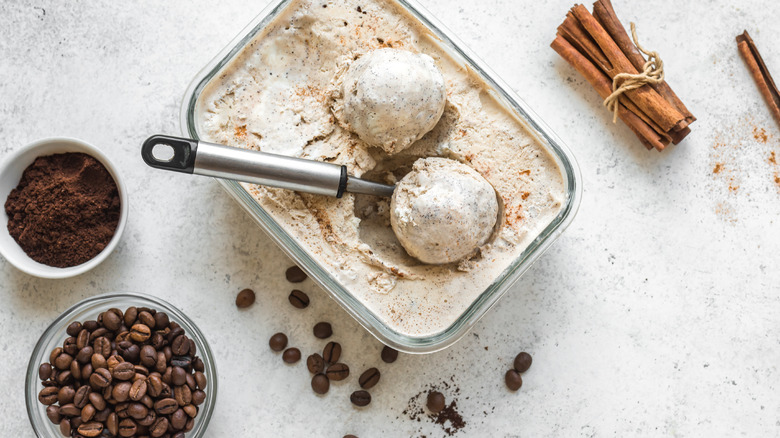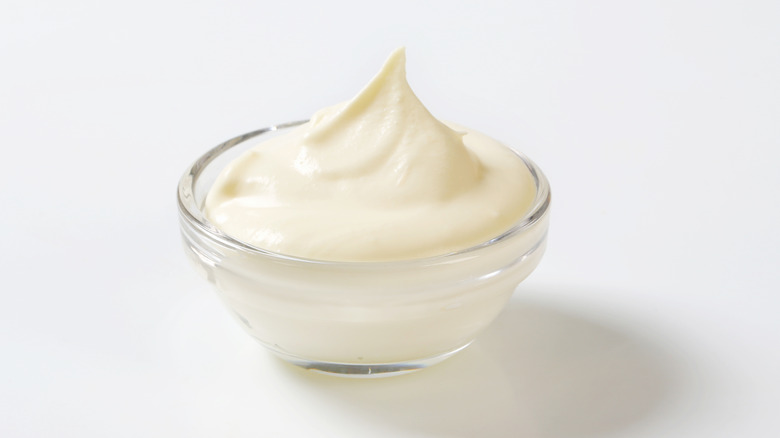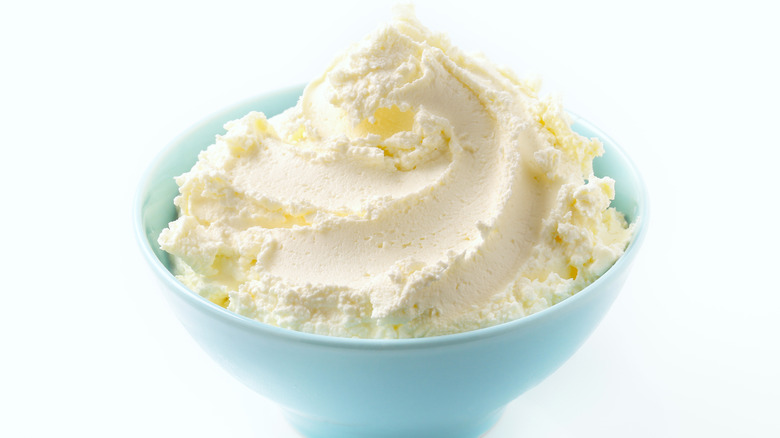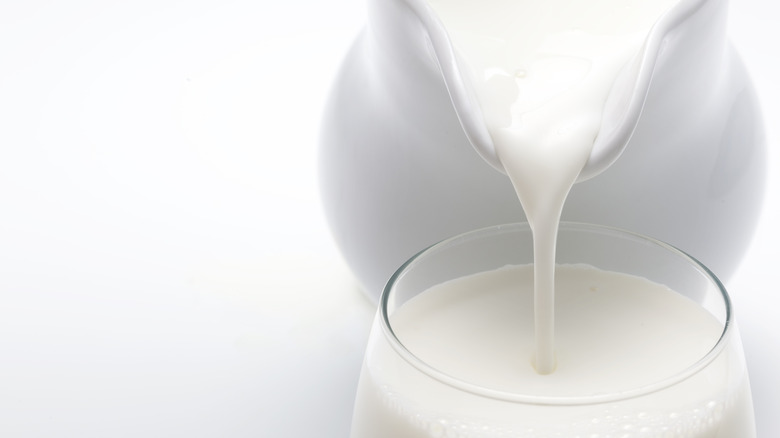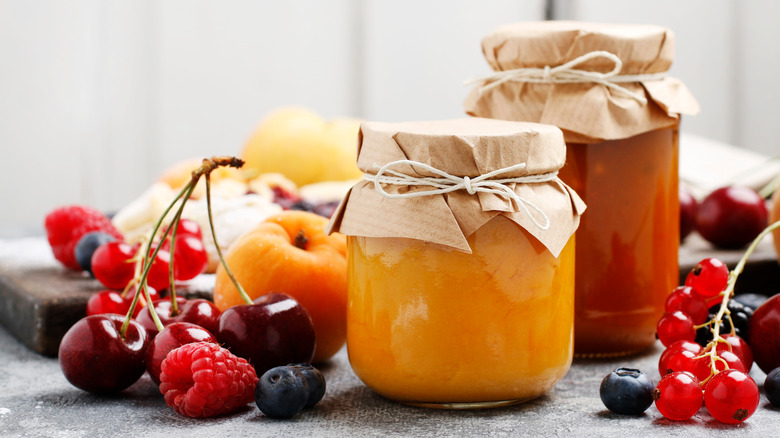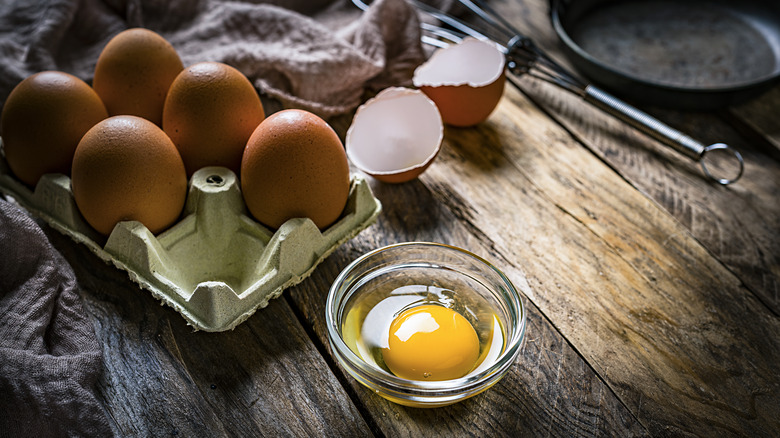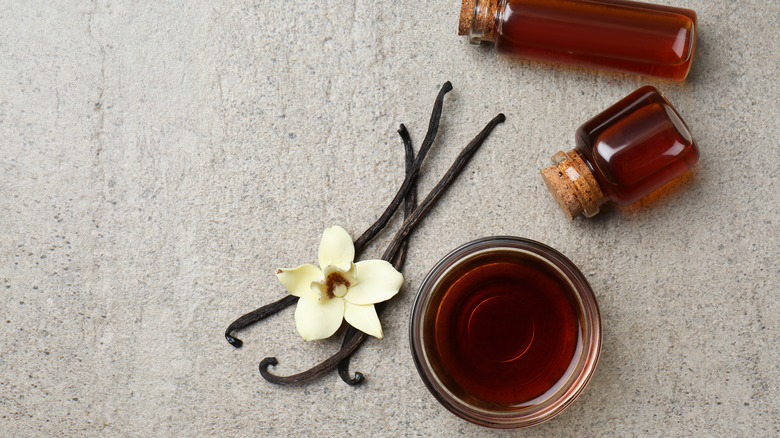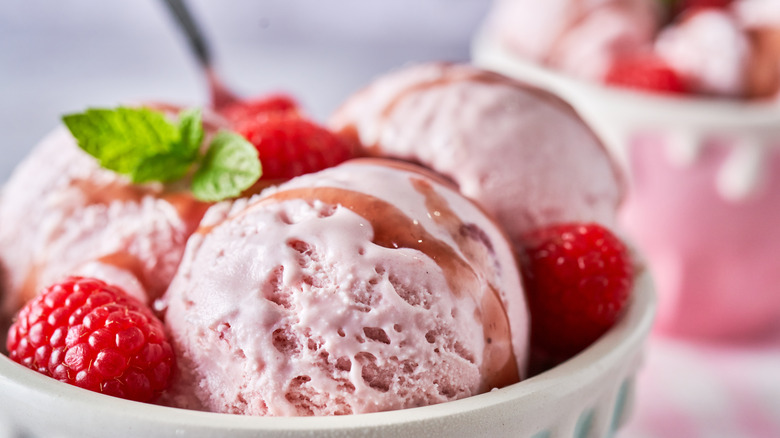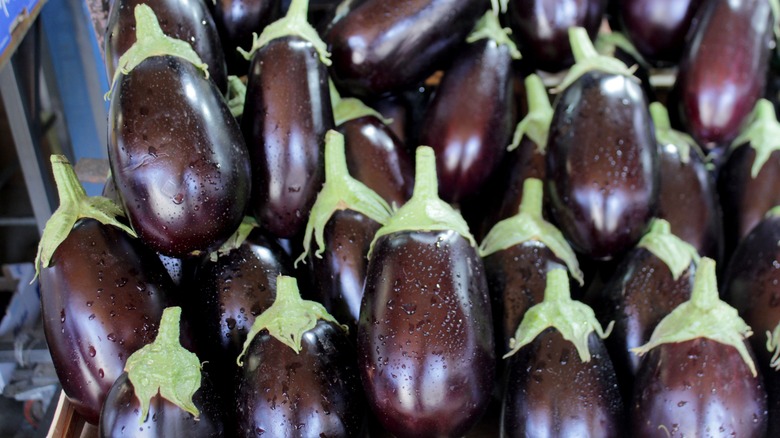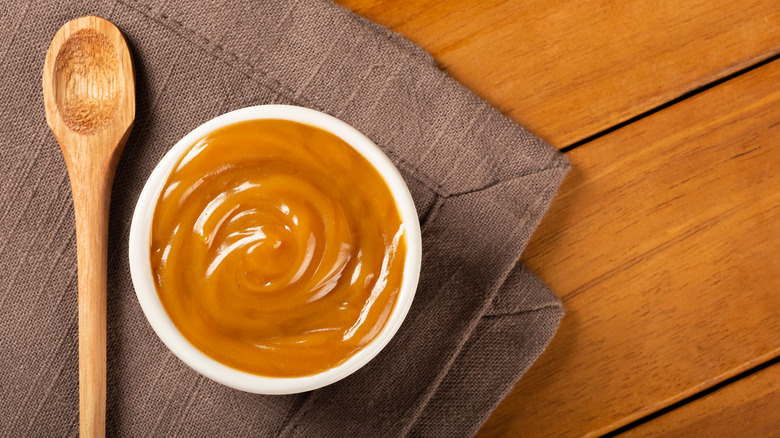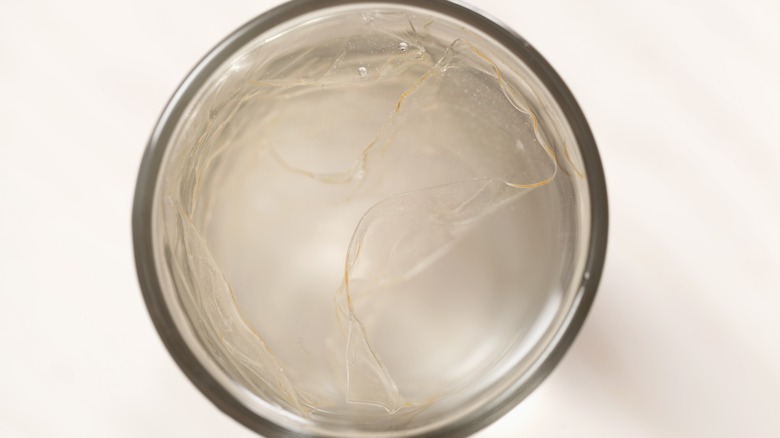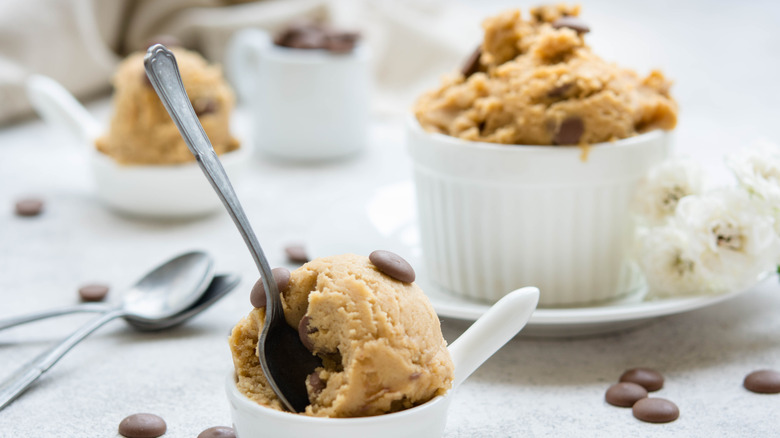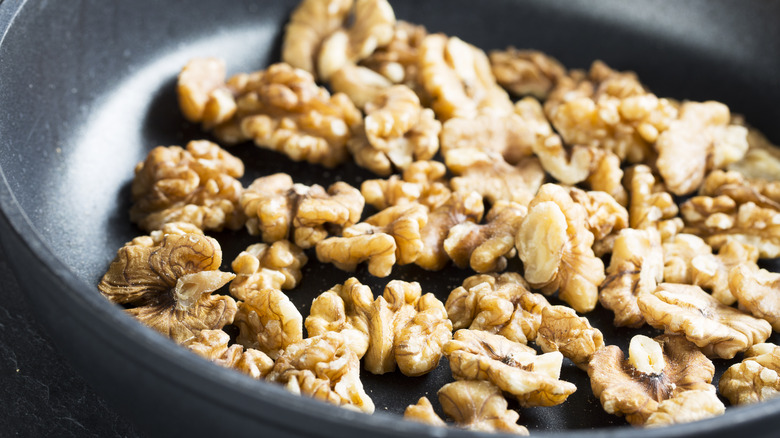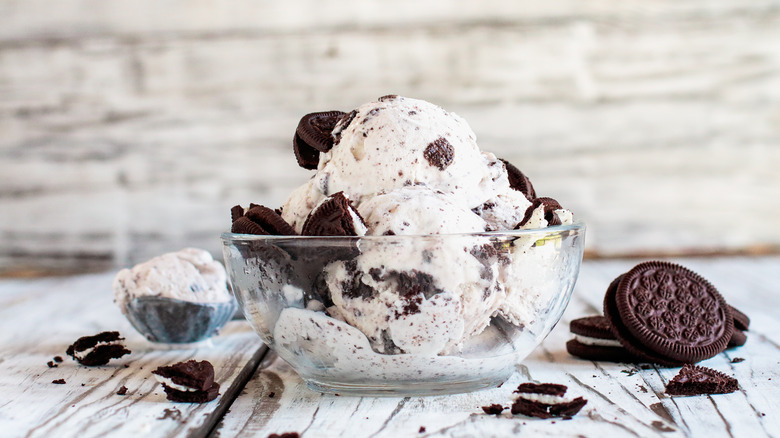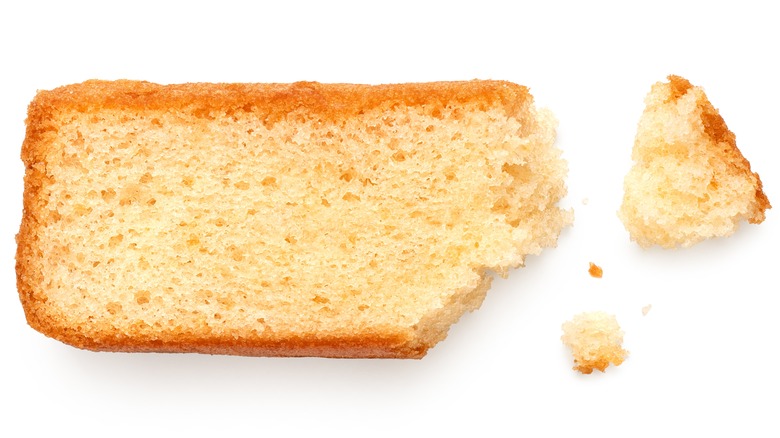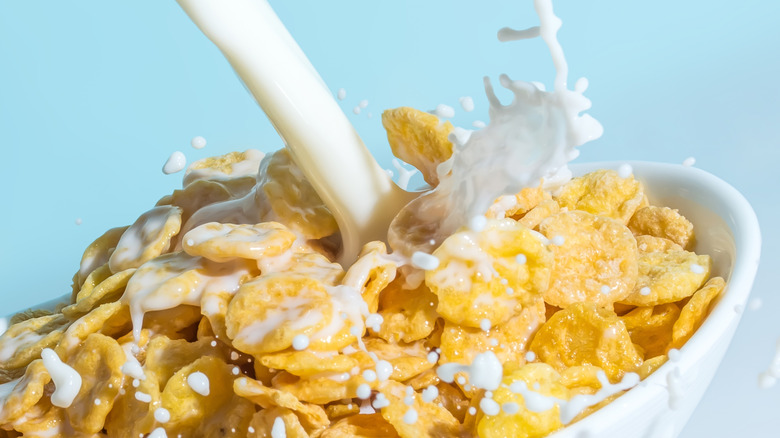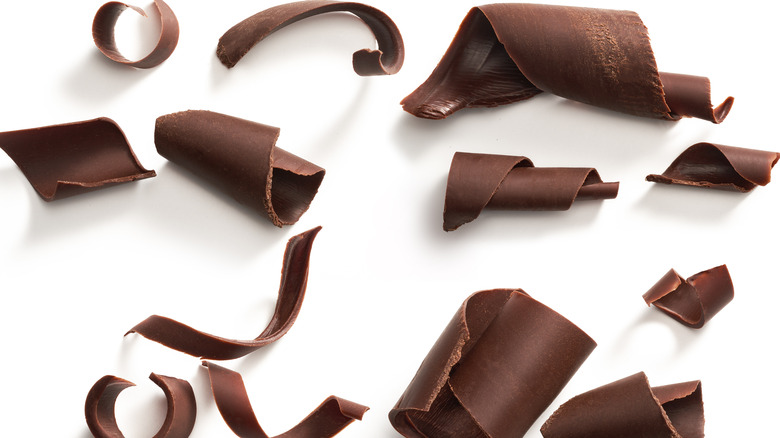17 Ingredient Additions To Elevate Homemade Ice Cream
We take for granted how easy it is to walk into the grocery store and pick out a pint of Ben & Jerry's ice cream. While buying pre-made ice cream from the freezer section is as easy as it is satisfying, there's something deliberately impersonal about buying a pint (or two). Instead, making homemade ice cream allows you to master a good base and customize your ice cream with whatever mix-ins your tastebuds fancy. And while there is an art behind making homemade ice cream, there is also a science.
Ice cream is an emulsion of a few basic ingredients: ice crystals, fat, sweeteners, air, and other solids (like proteins, mineral salts, and our favorites — the flavorings). When these ingredients come together at the proper ratio, you'll get a perfectly scoopable ice cream bound to satisfy your tastebuds on a hot summer day. Consider adding these preferred ingredients to homemade ice cream to improve both flavor and texture.
Sour cream
Most ice cream bases start with similar ingredients: heavy cream, half-and-half, sugar, and vanilla. The fat in these ingredients helps add richness and stability to the base, while the sugar lowers the mixture's freezing point, thus preventing the ice cream from freezing as a solid block. But there are some variations you can make in the base of your ice cream to create a creamier base.
The tangy ingredient you should add to homemade ice cream is sour cream. Sour cream has a higher milk fat content, meaning it is silkier than the heavy cream and half-and-half often used in ice cream. The cultures in the sour cream also create a subtle tang that will make your base flavor more well-rounded. If you add sour cream, you'll need to reduce the amount of milk and cream in your recipe — but still maintain a high-fat ratio that will keep your dessert smooth.
Cream cheese
Dairy products are a prominent ingredient in ice cream. But one ingredient that you may have never thought to add to your frozen treats will change your homemade ice cream forever. It's one of the ingredients that is used by Jeni Britton Bauer, owner of Jeni's Splendid Ice Creams, to make a thick, velvety ice cream base for her extravagantly flavored pints. The cream cheese is vital because it provides stability and structure, prevents the water from seeping out of the milk, and slows ice crystal formation — which would otherwise detract from the texture of the ice cream.
In addition, cream cheese helps make the ice cream thick. This is because the cream cheese is filled with milk proteins, which trap more air as the ice cream is churned. In turn, this creates a highly-desirable chewy texture.
Half-and-half
One of the staple ingredients in ice cream is heavy cream. This is because heavy cream has a high-fat content, between 35% and 40%, which allows the ice cream to hold its shape when it's whipped. However, one of the drawbacks of using heavy cream is its flavor. The fat in the cream lends to a very buttery, slightly saltine flavor when the cream is churned. While a little buttery flavor is a good thing, too fatty of a taste can take away from other ingredients in your ice cream.
The ingredient swap you should instead try for homemade ice cream is using half-and-half instead of heavy cream. Half-and-half contains some milk fat, between 10.5% and 18%, which allows the ice cream to hold its shape, but not so much that it tastes like butter when churned.
Fruit preserves
"Good Eats" host and culinary wizard Alton Brown has a very varied knowledge of food and cooking. So it wouldn't be surprising to see that he also has strong opinions on ice cream. One of the ingredient swaps that Alton Brown uses in homemade ice cream is replacing some of the sugar in his ice cream base with fruit preserves. Brown removes three tablespoons of sugar in his recipe and replaces it with three tablespoons of peach preserves for "extra smoothness in my ice cream and a little accent flavor" (via Food Network).
Fruit preserves are a great addition to homemade ice cream because the preserves contain pectin, a gel-based stabilizer that acts similarly to gelatin. This improves the structure of the ice cream while also giving it a mild peachy flavor. If peachy notes contrast the other ingredients you add, Brown suggests adding liquid pectin instead.
Liqueurs
Several celebrity chefs have noted that the secret ingredient for great homemade ice cream can be found in your liquor cabinet. Ina Garten makes homemade ice cream her own by adding Grand Marnier orange liqueur and Sauternes (white wine) to her homemade peach ice cream recipe. She also upgrades her store-bought ice cream by adding a hefty dose of Limoncello liqueur and store-bought biscotti ice cream to a scoop or two of vanilla ice cream — although the same trick applies to homemade vanilla ice cream, too.
Chef Nigella Lawson also uses booze for her no-churn vanilla ice cream base. Her clever base for this no-churn ice cream variety uses heavy cream, sweetened condensed milk, espresso powder, and espresso liqueur. Alcohol is a beneficial ingredient for ice cream because it has a lower freezing point than water, thus preventing the ice crystals from hardening and making your ice cream more like Italian ice. You should only plan to use one or two tablespoons of liqueur for your ice cream to prevent making it too watery or disrupting the other flavors.
Egg yolks
There are few ingredients as crucial in cooking and baking as eggs. These nutritional powerhouses are used for everything from binding meatballs to adding a fluffy rise to your favorite cake recipe. However, one of the best uses for eggs in the kitchen — specifically the yolks — is in ice cream. You should always add egg yolks to homemade ice cream because this part of the egg is comprised mainly of proteins and fats. The protein helps capture the water in the ice cream base, in turn prohibiting the buildup of ice crystals and ensuring a smooth treat.
One of the primary chemical components in egg yolks is emulsifiers, like lecithin. The emulsifiers help bind the fats and the water together in the recipe, thus creating a rich buttery texture. The egg's chemical structure also improves the stability of the ice cream — which means it's less likely to melt.
Extracts
Any prolific baker has an array of extracts and flavorings on hand for their creations. The same should be said about folks who love making their own ice cream recipes. For example, if you have peppermint extract on hand, you can make peppermint ice cream year-round. This recipe rounds out the flavors with one teaspoon of peppermint extract and one teaspoon of Mexican vanilla extract, which complements the confectionary flavor of the crushed candy cane pieces.
Extracts can be really helpful to use for making ice cream for several reasons. First, you can add the essence of flavors that would otherwise not be a good fit for ice cream — either because they're not pungent enough, too watery, or ice up faster than the base around it. The extracts also won't dilute your butterfat content, meaning that your ice cream won't noticeably change in texture compared to adding ingredients with protein, sugars, or water. Remember, ratios are essential when making ice cream!
Fruit
Not all people are on team fruit when it comes to ice cream (we think strawberry ice cream is an abomination, but that's another story) — but it does have its textural merits —provided, of course, that you use the right kind of fruit for your ice cream. Most fruits are brimming with water, which in turn means that your ice cream will come out with a ton of ice crystals in it. The fruits that do best in ice cream are the ones that can be made into jams, preserves, and alike. Blueberries, strawberries, raspberries, papaya, and peaches are some fruits that don't pose a textural hurdle to your creamy confection.
You can cook down the heartier fruits, like peaches and plums, to soften them, while delicate fruits can be left whole. Then, try blitzing down the fruit and straining it to remove the seeds before mixing it into your ice cream for a more fruity flavor throughout the base.
Eggplant
Eggplant ... ice cream? This unexpected ice cream flavor gives us all the weird feelings. But fear not; we're not just plopping eggplants into an ice cream base and calling it a day. You can make eggplant ice cream instead by sprinkling slices of the vegetable with sugar to allow them to sweat it out. Then, simmer the eggplant in syrup and accentuate it with vanilla and cardamon. We bet that you can't even taste the aubergine.
Another method for incorporating eggplant into your ice cream is to char it on a gas flame, broiler, or grill. The eggplant can be mixed with a medley of sweet and savory ingredients — like salty tamari, spicy ginger, and toffee-like brown butter — to elevate its flavor beyond that of a bland vegetable.
Dulce de leche
The best Häagen-Dazs ice cream flavor is obviously and unequivocally dulce de leche. This canned caramel-colored milk roughly translates from Spanish as "candy made from milk." The Latin American confection is made by slow-cooking sweetened condensed milk until toasty, creamy, and caramel-like. It differs from caramel because it is made from sugar and cooked quickly on high heat, while dulce de Leche is cooked low and slow to develop its consistency and color.
Our no-churn vanilla dulce de leche ice cream recipe uses store-bought dulce de leche (find it in the Latin grocery aisle) and mini salted pretzels for a sweet and salty contrast. The base of the ice cream is made by hand-whipping cream in a bowl before combining it with condensed milk, layering it in a loaf pan, and allowing the dessert to harden for at least eight hours before diving in.
Gelatin
Homemade ice cream typically doesn't soften as fast as store-bought because store-bought varieties use ingredients that help hold the air in the ice cream and keep it fluffy. Gelatin is one of the most widely-available stabilizers that home cooks can add to their ice cream to help keep it soft. Adding gelatin is also vital if you want to prevent ice crystals from building up.
You should use one packet of unflavored gelatin for every six cups of the ice cream mixture. First, place the sheets in some of the mixtures to allow them to soften before heating them and adding them to the rest of the cream. If you are making vegan ice cream or want to avoid using gelatin, agar agar powder, and xanthan gum may be suitable alternatives. It is important to remember that some fruits contain bromelain, an enzyme that prevents gelatin from thickening a mixture. These fruits, such as mango, papaya, and kiwi, must be cooked down to deactivate the enzyme — or an alternative for gelatin should be used.
Cookie dough
We have a soft spot in our hearts for cookie dough ice cream. If you choose to add this childhood favorite to your homemade ice cream, you'll need to take a few precautionary steps to ensure that your cookie dough is safe to eat raw. You can make edible cookie dough with almond flour (raw white flour can be a potential vector for foodborne illness) and without eggs — meaning that it is totally safe to eat raw.
If you want to avoid the mealy flavor of the almond flour, or you have a nut allergy, you can bake regular flour on a sheet pan for five minutes to kill off any lurking bacteria. You'll want to add the cookie dough pieces, along with any chocolate chips, during the last churn of your batter.
Toasted nuts
Toasted nuts can provide a mild and crunchy flair to your homemade ice cream. You'll want to use toasted nuts for your recipe rather than raw ones because toasting them helps develop the texture and flavors more than leaving them raw. You can toast your nuts in the oven or on the stovetop; the oven method is our favorite because it's a little more hands-off. Place a single layer of the nuts on a baking sheet and bake at 350 degrees Fahrenheit until the nuts emit a toasty odor.
After you've toasted your nuts, it's essential to adequately chill them before mixing them into the rest of your ice cream base. This is because ice cream can be fussy; adding chunks of warm ingredients to a cold base can cause pockets of melting.
Cookies and candies
Adding cookie and candy pieces to your ice cream are easy ways to add texture, pleasant taste, and youthful energy to your homemade ice cream. But the big question with these confections is how much to add. If you're making a whole quart of ice cream, you should add a half-cup of mix-ins so long as you're looking for a "one-chunk here, one chunk there" ice cream experience. But if you want a one-way ticket to Chunkytown, aim for a cup of mix-ins for each quart. Although you might think this amount is somewhat conservative for an entire quart, it ensures you get a good suspension of your mix-ins within the ice cream.
If you're adding cookie pieces, you should sift your mix-ins before adding them to the ice cream. This ensures your base stays silky smooth and free from any leftover cookie dust. Also, be sure to chop your candy pieces finely to ensure you get a little bit of every flavor in each bite.
Cake pieces
Cake pieces are one of the most underrated ingredients to add to ice cream. Depending on the type of cake you use (we love crumbled pound cake — a remix of strawberry shortcake, anyone?), you'll get a soft (not soggy) piece of cake surrounded by ribbons of fair ice cream. Your go-to method for incorporating cake pieces into ice cream should be after it has finished churning but before it's set. Layering the cake pieces may result in poor distribution, so you should instead opt to fold the pieces in with a trusty kitchen spatula.
When adding cake to your recipe, consider buying a pre-made cake (believe us, it's much easier than making your own and cooling it), chopping it into a diversity of cube sizes, and freezing the cake for at least 30 minutes before mixing them into your ice cream. This will reduce the disintegration of the cake pieces that will inevitably occur when you combine the pieces into the cream.
Cereal milk
You know, cereal milk? Like the delicious medley of flavors left over in your bowl after you've finished your Fruit Loops or Captain Crunch? Talk about Sunday morning nostalgia.
To make cereal milk ice cream, you'll just need to take some extra prep steps. First, you'll want to mix your ice cream base ingredients, like the heavy cream, sugar, milk, and extracts, together overnight with your desired breakfast cereal. Allow the mixture to steep overnight, covered. Then, when you're ready to churn your ice cream, strain out the soggy, spent cereal and press it out to extract as much of the cream as possible. Then, churn your ice cream as you normally would. Our favorite cereal type is Cinnamon Toast Crunch, but we could also get behind some Cocoa Pebbles action.
Chocolate shavings
You probably wouldn't think twice about adding chocolate to your homemade ice cream. But, the chilly conditions of ice cream aren't always conducive to chocolate. When most types of chocolate get too cold, the texture gets unappetizingly chalky. Chocolate chips contain stabilizer ingredients, which means they come out too waxy and hard in ice cream. Is there any possible remedy to this chocolate conundrum?
One of the potential solutions to adding chocolate to ice cream is to make stracciatella. This involves ribboning the chocolate into the ice cream as it's churning, producing short pieces that are velvety in the mouth. To use this technique, mix the chocolate with a few teaspoons of neutral oil. Then, drizzle the chocolate in during the last few minutes of churning. This timing will prevent your whole ice cream from turning brown and leave you with delicate, chocolatey swirls.
